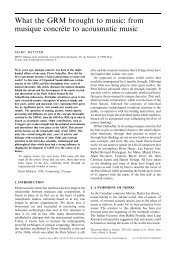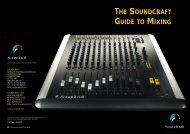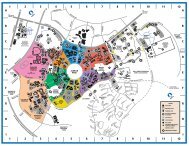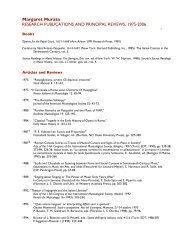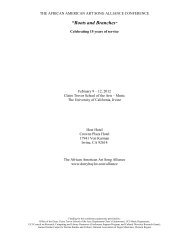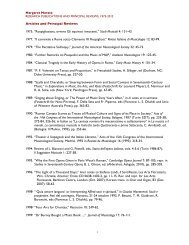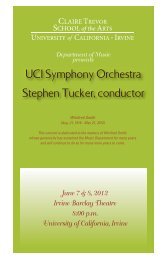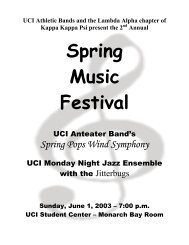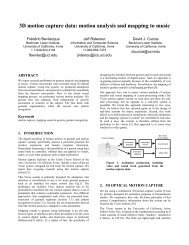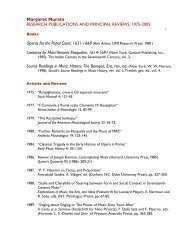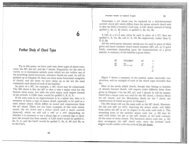amy bauer The Other of the Exotic: Balinese Music as Grammatical ...
amy bauer The Other of the Exotic: Balinese Music as Grammatical ...
amy bauer The Other of the Exotic: Balinese Music as Grammatical ...
You also want an ePaper? Increase the reach of your titles
YUMPU automatically turns print PDFs into web optimized ePapers that Google loves.
<strong>The</strong> <strong>O<strong>the</strong>r</strong> <strong>of</strong> <strong>the</strong> <strong>Exotic</strong> 359<br />
geneity <strong>of</strong> pitch and interval within each collection, a carefully notated hierarchy<br />
<strong>of</strong> attack intensity, combined with <strong>the</strong> audible cues <strong>of</strong> register change and a wide<br />
dynamic comp<strong>as</strong>s, promotes select melodic events which help shape this and<br />
later sections <strong>of</strong> <strong>the</strong> Étude.<br />
Ex. 14 reveals an underlying contrapuntal structure which tightens <strong>as</strong> Section<br />
1 continues.Three ‘middleground’ events in each <strong>of</strong> two phr<strong>as</strong>es – <strong>the</strong> rising and<br />
falling countersubject, ‘composed-in’ register transfers and a descending five-line<br />
phr<strong>as</strong>e – work in tandem with <strong>the</strong> accent pattern and <strong>the</strong> expansion <strong>of</strong> register<br />
noted above. In <strong>the</strong> first phr<strong>as</strong>e (bars 1–17), a three-whole-tone <strong>as</strong>cent to ˆ4 in<br />
octave 5 shifts to octave 6 (B5–B6).<strong>The</strong> D♭7 (ˆ5) in bar 12 becomes <strong>the</strong> first note<br />
<strong>of</strong> a graduated descent, which is expanded both by <strong>the</strong> second <strong>the</strong>me and by<br />
repetitions <strong>of</strong> <strong>the</strong> countersubject (see again Ex. 13) before coming to rest on ˆ1 in<br />
octave 6 over contrapuntal support from <strong>the</strong> left hand in octaves 4 and 5. <strong>The</strong><br />
b<strong>as</strong>s enters decisively on <strong>the</strong> downbeat <strong>of</strong> bar 17 with B♭3 (ˆ2 in <strong>the</strong> left hand);<br />
this <strong>the</strong>n transfers to octave 2, where it forms a 9 11 chord [0257] with A♭3, F4 and<br />
E♭5 (bar 18).<br />
Contrary motion in <strong>the</strong> b<strong>as</strong>s line intensifies an <strong>as</strong>cent to <strong>the</strong> seventh octave,<br />
which continues <strong>the</strong> registral expansion downwards. Solid- and broken-line<br />
brackets above a large-scale descent from ˆ2 to ˆ6 in <strong>the</strong> b<strong>as</strong>s indicate nested<br />
forms <strong>of</strong> <strong>the</strong> countersubject which move from <strong>the</strong> [0257] chord in bar 18<br />
towards greater dissonance between <strong>the</strong> hands. <strong>The</strong> juxtaposition <strong>of</strong> chords in<br />
each hand produces diatonic sonorities through to <strong>the</strong> end <strong>of</strong> bar 22. 32 From A5<br />
( ˆ3) in <strong>the</strong> right hand onwards, diatonic intervals are filled in to produce a series<br />
<strong>of</strong> symmetrical harmonies in bars 24–26, <strong>as</strong> indicated by <strong>the</strong> pitch-cl<strong>as</strong>s labels<br />
between <strong>the</strong> hands.<br />
Section 1 serves <strong>as</strong> a kind <strong>of</strong> contrapuntal exposition to <strong>the</strong> Étude <strong>as</strong> a whole:<br />
a two-bar introduction leads to a statement in two parts (bars 3–9) in which<br />
voices are gradually added. From three voices (bars 10–12) to four (bars 13–14),<br />
five (bars 15–20) and six (bars 21–29), <strong>the</strong> motion outwards from octaves 3–5 to<br />
octaves 1–8 is accompanied by stretto-like imitation <strong>of</strong> <strong>the</strong>matic motives, an<br />
accretion <strong>of</strong> linear density which is naturally followed by <strong>the</strong> ‘pedal notes’ <strong>of</strong> <strong>the</strong><br />
b<strong>as</strong>s progression A♭1/B♭2–E1/G♭2–C1/G♭1–D♭2. As <strong>the</strong> hands move fur<strong>the</strong>r apart,<br />
<strong>the</strong> accompanying harmonies grow denser and more chromatic. Eventually <strong>the</strong><br />
progression sounds – over thunderous ninths in <strong>the</strong> b<strong>as</strong>s – less like <strong>the</strong> cadence<br />
<strong>of</strong> a fugato p<strong>as</strong>sage in Bach or Beethoven and much more like <strong>the</strong> mutable<br />
overtones <strong>of</strong> <strong>the</strong> large gongs which mark <strong>the</strong> transition from one p<strong>as</strong>sage to <strong>the</strong><br />
next in <strong>the</strong> gamelan gong kebyar.<br />
Transformational Structure in ‘Galamb borong’<br />
I have made a c<strong>as</strong>e for gamelan gong kebyar not only <strong>as</strong> an influence on Ligeti’s<br />
Étude No. 7, but also <strong>as</strong> a structural model for an entire compositional approach,<br />
one which includes tonality, rhythmic procedure, polyphony and form.Yet, <strong>as</strong> my<br />
motivic analysis suggests, <strong>the</strong> work sounds like <strong>the</strong> product <strong>of</strong> a composer<br />
schooled exclusively in <strong>the</strong> études <strong>of</strong> Chopin, Liszt and Debussy. In a sense,<br />
<strong>Music</strong> Analysis, 27/ii-iii (2008)<br />
© 2009 <strong>The</strong> Author.<br />
Journal compilation © 2009 Blackwell Publishing Ltd.



